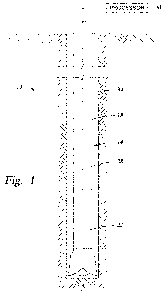Une partie des informations de ce site Web a été fournie par des sources externes. Le gouvernement du Canada n'assume aucune responsabilité concernant la précision, l'actualité ou la fiabilité des informations fournies par les sources externes. Les utilisateurs qui désirent employer cette information devraient consulter directement la source des informations. Le contenu fourni par les sources externes n'est pas assujetti aux exigences sur les langues officielles, la protection des renseignements personnels et l'accessibilité.
L'apparition de différences dans le texte et l'image des Revendications et de l'Abrégé dépend du moment auquel le document est publié. Les textes des Revendications et de l'Abrégé sont affichés :
| (12) Demande de brevet: | (11) CA 2716233 |
|---|---|
| (54) Titre français: | SYSTEME ET PROCEDE DE MESURE AU FOND DU TROU PENDANT LE FORAGE |
| (54) Titre anglais: | DOWNHOLE MEASUREMENT WHILE DRILLING SYSTEM AND METHOD |
| Statut: | Réputée abandonnée et au-delà du délai pour le rétablissement - en attente de la réponse à l’avis de communication rejetée |
| (51) Classification internationale des brevets (CIB): |
|
|---|---|
| (72) Inventeurs : |
|
| (73) Titulaires : |
|
| (71) Demandeurs : |
|
| (74) Agent: | MARKS & CLERK |
| (74) Co-agent: | |
| (45) Délivré: | |
| (86) Date de dépôt PCT: | 2009-02-19 |
| (87) Mise à la disponibilité du public: | 2009-08-27 |
| Requête d'examen: | 2010-08-19 |
| Licence disponible: | S.O. |
| Cédé au domaine public: | S.O. |
| (25) Langue des documents déposés: | Anglais |
| Traité de coopération en matière de brevets (PCT): | Oui |
|---|---|
| (86) Numéro de la demande PCT: | PCT/US2009/034546 |
| (87) Numéro de publication internationale PCT: | WO 2009105561 |
| (85) Entrée nationale: | 2010-08-19 |
| (30) Données de priorité de la demande: | ||||||
|---|---|---|---|---|---|---|
|
Linvention concerne un procédé de mesure pendant le forage comprenant le positionnement dau moins un capteur au fond du trou et la transmission des données détectées pendant le forage depuis ledit capteur vers la surface sans stocker les données détectées au fond du trou. Linvention concerne également un système associé.
A method of measuring while drilling includes
positioning at least one sensor downhole; and transmitting
sensed data while drilling from the at least one sensor to
sur-face without storing the sensed data downhole and system.
Note : Les revendications sont présentées dans la langue officielle dans laquelle elles ont été soumises.
Note : Les descriptions sont présentées dans la langue officielle dans laquelle elles ont été soumises.

2024-08-01 : Dans le cadre de la transition vers les Brevets de nouvelle génération (BNG), la base de données sur les brevets canadiens (BDBC) contient désormais un Historique d'événement plus détaillé, qui reproduit le Journal des événements de notre nouvelle solution interne.
Veuillez noter que les événements débutant par « Inactive : » se réfèrent à des événements qui ne sont plus utilisés dans notre nouvelle solution interne.
Pour une meilleure compréhension de l'état de la demande ou brevet qui figure sur cette page, la rubrique Mise en garde , et les descriptions de Brevet , Historique d'événement , Taxes périodiques et Historique des paiements devraient être consultées.
| Description | Date |
|---|---|
| Inactive : CIB attribuée | 2024-06-24 |
| Inactive : CIB en 1re position | 2024-06-24 |
| Demande non rétablie avant l'échéance | 2013-02-19 |
| Le délai pour l'annulation est expiré | 2013-02-19 |
| Inactive : CIB désactivée | 2013-01-19 |
| Inactive : CIB désactivée | 2013-01-19 |
| Réputée abandonnée - omission de répondre à un avis sur les taxes pour le maintien en état | 2012-02-20 |
| Inactive : CIB attribuée | 2012-02-17 |
| Inactive : CIB en 1re position | 2012-02-17 |
| Inactive : CIB attribuée | 2012-02-17 |
| Inactive : CIB expirée | 2012-01-01 |
| Inactive : CIB expirée | 2012-01-01 |
| Inactive : Page couverture publiée | 2010-11-26 |
| Inactive : Réponse à l'art.37 Règles - PCT | 2010-11-05 |
| Inactive : Demande sous art.37 Règles - PCT | 2010-10-22 |
| Lettre envoyée | 2010-10-22 |
| Inactive : Acc. récept. de l'entrée phase nat. - RE | 2010-10-22 |
| Inactive : CIB attribuée | 2010-10-22 |
| Inactive : CIB attribuée | 2010-10-22 |
| Inactive : CIB attribuée | 2010-10-22 |
| Demande reçue - PCT | 2010-10-22 |
| Inactive : CIB en 1re position | 2010-10-22 |
| Exigences pour l'entrée dans la phase nationale - jugée conforme | 2010-08-19 |
| Exigences pour une requête d'examen - jugée conforme | 2010-08-19 |
| Toutes les exigences pour l'examen - jugée conforme | 2010-08-19 |
| Demande publiée (accessible au public) | 2009-08-27 |
| Date d'abandonnement | Raison | Date de rétablissement |
|---|---|---|
| 2012-02-20 |
Le dernier paiement a été reçu le 2010-08-19
Avis : Si le paiement en totalité n'a pas été reçu au plus tard à la date indiquée, une taxe supplémentaire peut être imposée, soit une des taxes suivantes :
Veuillez vous référer à la page web des taxes sur les brevets de l'OPIC pour voir tous les montants actuels des taxes.
| Type de taxes | Anniversaire | Échéance | Date payée |
|---|---|---|---|
| TM (demande, 2e anniv.) - générale | 02 | 2011-02-21 | 2010-08-19 |
| Taxe nationale de base - générale | 2010-08-19 | ||
| Requête d'examen - générale | 2010-08-19 |
Les titulaires actuels et antérieures au dossier sont affichés en ordre alphabétique.
| Titulaires actuels au dossier |
|---|
| BAKER HUGHES INCORPORATED |
| Titulaires antérieures au dossier |
|---|
| MICHAEL W. KING |
| RALF ZAEPER |